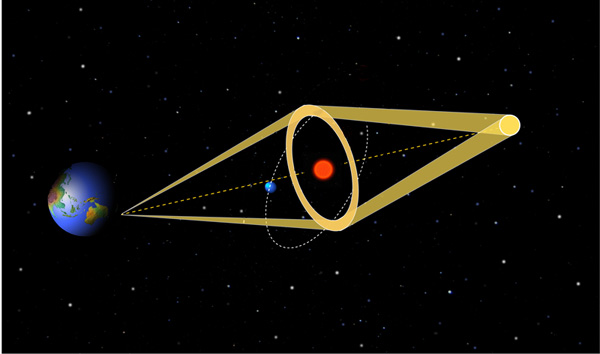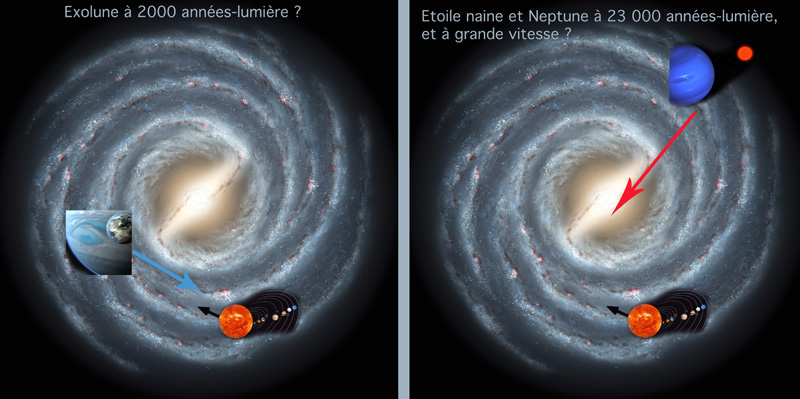THE FIRST EXOMOON?

An international team of astronomers, including researchers from IAP, consider the possibility of having discovered a gaseous free-floating planet and its exomoon, 2000 light years away in our Galaxy, via the microlensing technique...
Over the last 20 years, several methods probing different sections of the exoplanet population have been used: radial velocity, stellar transits, direct imaging, pulsar timing, transit timing, astrometry and gravitational microlensing. These 1850 discoveries have already challenged and revolutionized our theories of planet formation and dynamical evolution, providing a wide variety of systems. They include 472 multiple planet systems and 17 circumbinary planets. Moreover, a population of candidates for the free-floating planets has been found, i.e. isolated planets that have been either ejected from their system or formed by a spontaneous process.
However, our solar system presents a specificity that has still not been observed anywhere else: most of its planets (Earth, Mars, Jupiter, Saturn, Uranus, Neptune) have one or several natural satellites. What about the extrasolar systems? Do they possess exomoons and why would this be of interest? In some configurations, conditions for habitability could be more likely on the surface of satellites than on the planets themselves (particularly the gas giants). Two methods are used today to track them: in the case of a planet transiting its star, small perturbations in the light curve could be due to an exomoon. Several teams have been searching for such a signal in Kepler's data, but none has been discovered thus far. The other method is gravitational microlensing. A planet-moon couple can create a magnification of the light coming from a background star if it passes in front of this star. This technique has been successfully used for more than a decade to search for small and cold planets. In particular, the first super-Earth has been discovered by the PLANET collaboration in 2006 (Beaulieu et al. 2006, Nature). Later, statistics from the microlensing experiment established that planets around stars are the rule rather than the exception in our Galaxy (Cassan et al. 2012, Nature).
Gravitational microlensing effect. The light-rays from a background star (called source), for instance in the center of our Galaxy, are distorted by a mass in the foreground (star and/or planet) when the latter crosses its line of sight. As a result, the source's light is magnified during the time of the microlensing event. If the lensing system is composed of multiple objects, they can all create their own perturbation depending on the geometrical configuration.
© IAP
MOA-2011-BLG-262Lb is the first exomoon candidate found to date. It is a microlensing planetary system discovered in 2011 by the PLANET collaboration (Probing Lensing Anomalies NETwork), and MOA (Microlensing Observation in Astrophysics). The results have been published on April 10th 2014 by a team led by David Bennett (University of Notre Dame, Indiana, United States) and Virginie Batista (Institut d'Astrophysique de Paris, CNRS-UPMC, DIM ACAV, France).
Observations: in June 2011, the MOA-2011-BLG_262 microlens was observed simultaneously by the two MOA telescopes in New Zealand, and a PLANET telescope in Hobart (Tasmania). These 3 telescopes recorded a 75 minute perturbation due to the presence of a small companion to the primary lens. Other telescopes in Chile (Paranal, Las Campanas, and Cerro Tololo), as well as the Keck telescope in Hawaii have obtained complementary observations.
The analysis is very delicate, because we are in a rare situation in which the data can be explained by two possible scenarios. The first one corresponds to a massive planet of 4 times the mass of Jupiter, orbited by a small satellite of 0.5 Earth mass. This system would be situated at 600 parsecs from our Solar system (2000 light years) and would have the particularity of lacking a host star, being then a candidate to the free-floating planet population. Such a planet-moon couple could have been ejected from its original star-centric system, or could have been formed without star in a molecular cloud.
The second scenario slightly disfavored by the models, presents some very different characteristics, albeit a similar mass ratio: it corresponds to a small star of 0.12 solar mass, orbited by a 18 Earth-mass planet. This system would be much further away, near the center of the Galaxy at about 7 kiloparsecs, and would have a very fast proper motion compared to average stars in the Galactic bulge.
These two solutions present extraordinary characteristics, but it is not possible to disentangle them today, and both scenarios have been presented in the published Astrophysical Journal of April 10th 2014.
This figure shows our Galaxy seen from above. The Sun and its system are indicated by the black arrow. The left panel shows the first scenario, a massive planet and its exomoon situated quite close to our solar system (2000 light years away). The right panel shows the second scenario, a small star orbited by a Neptune-like planet almost 23,000 light years away. This system would be moving in the Galaxy at a high speed.
© IAP
The exomoons with sub-Earth masses, orbiting around gas giants, are detectable by gravitational microlensing. If these systems are common, we expect to discover more within the next years. Actual microlensing observations combined with simultaneous space observations (Spitzer or coming space missions like WFIRST), or simply wide distribution of ground based observations from distant sites, will enable us to detect this kind of system without any ambiguity. Indeed, parallax effects create subtle distortsions in the light curve of microlensing events that provide precious information on the observed system.
This work was a collaboration of researchers from France, United States, New Zealand, Australia, England, and Germany, using telescopes in the southern hemisphere (Australia, New Zealand, Chile) and Hawaii. The French part has been funded by the DIM ACAV programme of Région Île-de-France, with the support of Programme National de Planétologie (INSU-CNRS), Institut d'Astrophysique de Paris (CNRS-UPMC), the Ohio State University, NASA and NSF. The PLANET observational campaign was partly funded from 2007 to 2011 by the French National Agency of Research, ANR HOLMES.
French team: Virginie Batista, Jean-Philippe Beaulieu, Arnaud Cassan, Christian Coutures, Jean-Baptiste Marquette (Institut d'astrophysique de Paris), Etienne Bachelet, Pascal Fouqué (IRAP, Toulouse).
Article scientifique publié le 10 avril 2014 : Bennett D.P., Batista V., Bond I.A., Bennett C.S., Suzuki D., Beaulieu J.P., Udalski A., Donatowicz J., Abe F., et al., 2014, "A Sub-Earth-Mass Moon Orbiting a Gas Giant Primary or a High Velocity Planetary System in the Galactic Bulge", Astrophysical Journal, astroph
Collaborations, observatories, telescopes: PLANET, OGLE, MOA, KECK, ESO, Vista telescope, DIM ACAV, Programme National de Planétologie.
Two of the telescopes involved in the analysis:
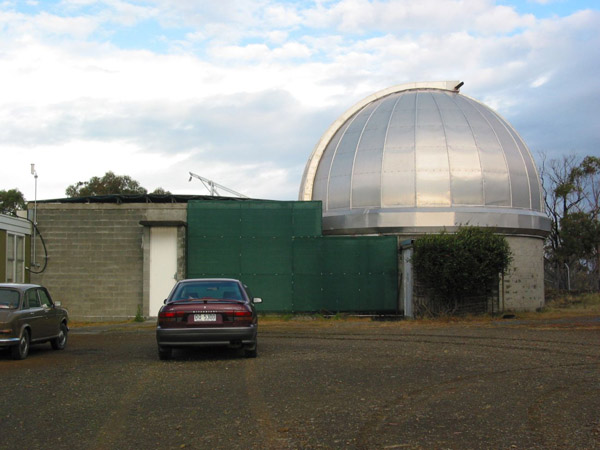
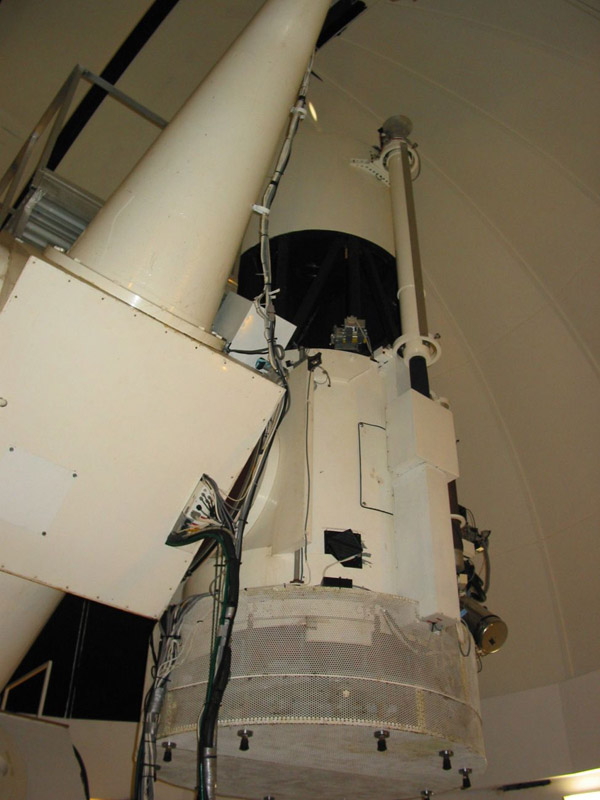
Canopus 1m telescope of the University of Tasmania, Hobart, Australia.
© IAP
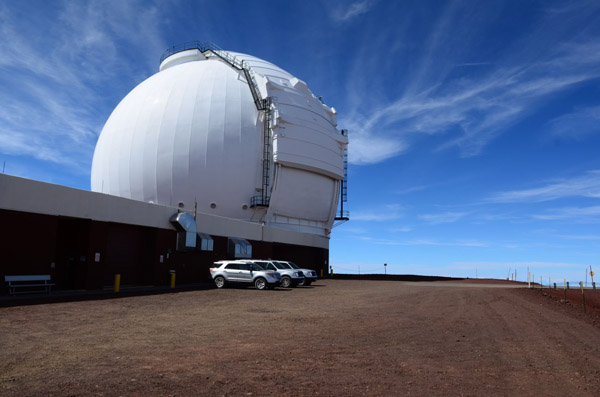
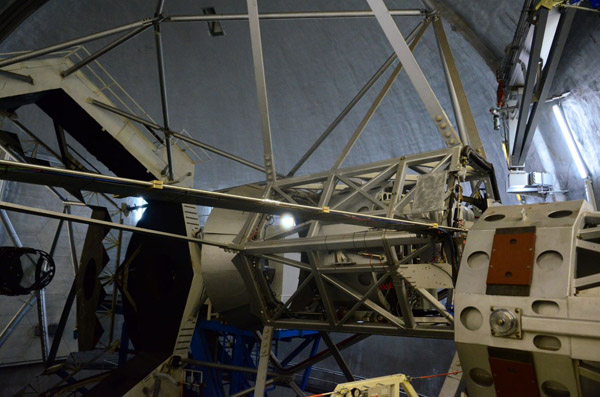
NASA Keck 10m telescope at Mauna Kea in Hawaii, United States.
© IAP
Two figures from the scientific paper:
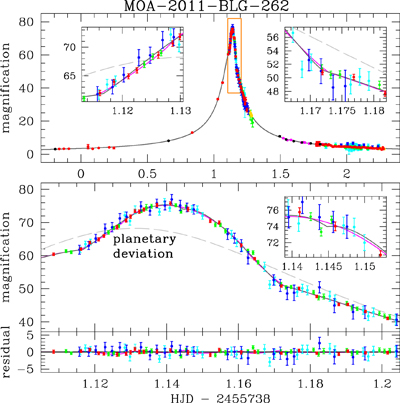
Light curve of MOA-2011-BLG-262 where data are presented in different colors: from New Zealand: MOA 1.8m in red, and Mt. John University Obs. in green and cyan, from Tasmania: Canopus 1m, and from Chile: CTIO in magenta, and OGLE in black
© IAP
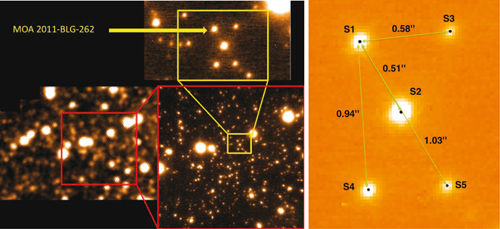
Field of view around the target. On the left panel, an image taken from the 4m Vista telescope of ESO, and two zooms obtained with the Keck telescope. On the right panel, a zoom of the target and its neighbors, showing the separation in arcsec.
© IAP
Contacts:
Virginie Batista
Institut d'astrophysique de Paris-CNRS-UPMC
batista at iap.fr
Tel. : 33-1-4432-8034
(previously researcher at the Ohio State University, United States (until Feb, 2014), and currently at Institut d'Astrophysique de Paris, France)
Jean-Philippe Beaulieu
Institut d'astrophysique de Paris-CNRS-UPMC
beaulieu at iap.fr
Tel. : 33-1-4432-8119
(directeur de recherche at Institut d'astrophysique de Paris-CNRS UPMC)
A 4'30" movie is available (in french) on YouTube.

April 2014

